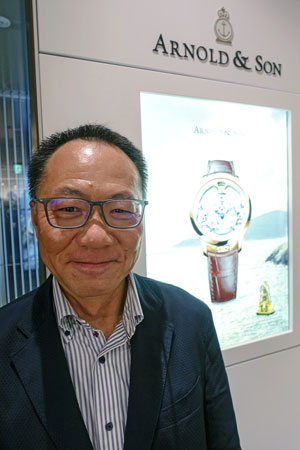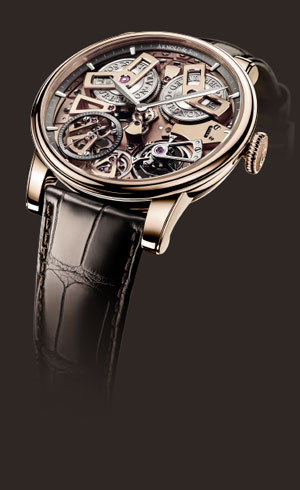
Hiroyuki Baba heads Citizen Watch sales department
In 1764, British watchmaker John Arnold presented King George III with the smallest repeating watch that had ever been created, enchanting the monarch and cementing the growing reputation of the Cornwall-born designer. His fame and clientele grew and, in the intervening centuries, the Arnold & Son brand has become synonymous with precision, the very highest levels of workmanship and some unique takes on styling.
Those qualities have helped to make the brand a firm favourite among watch connoisseurs and enabled it to develop a following in Japan, which was one of the reasons that the world’s only standalone Arnold & Son boutique opened in Tokyo’s Ginza Six commercial complex in April.
“These watches really are unique and of the highest quality, and that makes them very attractive to people who value those qualities and are looking for something new and interesting”, said Hiroyuki Baba, head of the multi-brand sales department for Citizen Watch Co., Ltd., which acquired the Arnold & Son brand in 2012.
“Buyers of the brand are wealthy—they are typically business owners, doctors or lawyers—and may already have four or five very expensive watches in their collection. But they buy an Arnold & Son watch because of the heritage and because it is different”, he told BCCJ ACUMEN.
That typical type of consumer makes sense—anyone who covets one of these timepieces will need deep pockets. The Ginza shop stocks 30 of the brand’s 50 models, with the top of the range watch going for a cool ¥22.2mn. In 2016, a John Arnold 23/78 Chronometer was auctioned by Sotheby’s in London and went for a record £577,000, several times its original estimated sale price.
The Arnold & Son boutique is adjacent to the new Citizen flagship store in Ginza Six, but clearly differentiates itself from the parent firm. While Citizen aims to cater to every taste and price range, Arnold & Son knows precisely who its customers are.
The brand produces two ranges: the Royal Collection is in recognition of its historic links to the British royal family and incorporates design elements that hark back to Arnold’s earliest watches, such as cases that replicate those of early pocket watches. Many of the line are limited edition pieces and utilise a tourbillon, a mechanism to protect the internal mechanism from the effects of gravity by mounting the escapement and balance wheel in a rotating cage. A tourbillon is still considered a mark of watch-making excellence in high-end pieces.
The second range is the Instrument Collection, which is inspired by Arnold’s work producing marine chronometers. Working with other watchmakers of the day, Arnold addressed the problem of determining longitude and won grants and awards from parliament for his achievements. Arnold’s chronometers helped the East India Company establish its empire, and Napoleon Bonaparte presented an Arnold timepiece to the Brera Observatory in Milan in 1802, three years after the designer’s death.
And while the Royal Collection uses images of Buckingham Palace and the Palace of Westminster’s Elizabeth Tower in its promotional material, the Instrument Collection is backed by rugged British coastlines and high seas.
Despite their British heritage, all Arnold & Son watches are today designed and manufactured in Switzerland, with three or four new products added to the ranges each year. Traditionally, one is unveiled at Baselworld, the watch and jewellery show that is the highlight of the industry calendar and is held in the Swiss city each spring.

The Tourbillon Chronometer No.36
This year Arnold & Son unveiled the 18-karat red gold Tourbillon Chronometer No. 36 at the event. The tourbillon in each watch takes two weeks to manufacture and assemble, while slightly less than two months are required to complete each piece.
A single craftsman puts each timepiece together, while designers are working on future editions as much as two years ahead of their release date. And Arnold & Son prides itself on not cutting corners. While other manufacturers may place a previously used mechanism into a newly designed case and call it a completely new watch, Arnold & Son enhances and refines the mechanism for each new release.
The store sold two watches in the first two weeks after it opened—a response that Baba described as “excellent”—but he accepts that more needs to be done in the Japanese market to raise the profile of the brand.
The other obstacle that all manufacturers face in Japan today is the declining importance of watches, as young people rely increasingly on their mobile phones.
“Younger people today don’t think they need a watch, but when it comes to business, a good watch is still a mark of professionalism”, Baba said.



